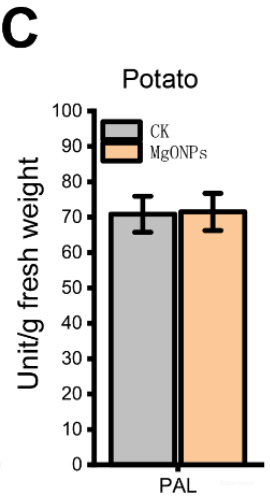Phenylalanine Ammonia Lyase (PAL) Activity Assay Kit
SKU: E-BC-K522-S-100
Phenylalanine Ammonia Lyase (PAL) Activity Assay Kit
| SKU # | E-BC-K522-S |
| Detection Instrument | Spectrophotometer (290 nm) |
| Detection Method | Colorimetric method |
Product Details
Properties
| Synonyms | PAL |
| Sample type |
Serum, plasma, animal tissue, cells |
| Sensitivity | 0.78 U/g tissue |
| Detection range | 0.78-156 U/g tissue |
| Detection method |
Colorimetric method |
| Assay type | Enzyme Activity |
| Assay time | 70 min |
| Precision | Average inter-assay CV: 4.600% | Average intra-assay CV: 3.100% |
| Other instruments required | Tubes, Micropipettor, Vortex mixer, 37°C Incubator |
| Storage | 2-8℃ |
| Valid period | 12 months |
Images
ZL Wang et al investigate the toxicity effects and mechanisms of MgO nanoparticles on the oomycete pathogen. Phenylalnine ammonia lyase (PAL) activity of potato tissue was determined using PAL activity assay kit (E-BC-K522-S).

No significant change of PAL activity can be observed after serving with MgONPs.
Dilution of Sample
It is recommended to take 2~3 samples with expected large difference to do pre-experiment before formal experiment and dilute the sample according to the result of the pre-experiment and the detection range (0.78-156 U/g tissue).
The recommended dilution factor for different samples is as follows (for reference only):
| Sample type | Dilution factor |
| 10% Epipremnum aureum tissue homogenate | 1 |
| 10% Carrot tissue homogenate | 1 |
| 10% Green pepper tissue homogenate | 1 |
| 10% Corn grain tissue homogenate | 1 |
Note: The diluent is reagent 1.
Detection Principle
Phenylalanine ammonia lyase (PAL) can catalyze L-phenylalanine to produce trans-cinnamic acid and ammonia, and trans-cinnamic acid has the maximum absorption peak at 290 nm. PAL activity can be calculated by measuring the increase of OD value at 290 nm.
Kit Components & Storage
| Item | Component |
Size 1 (50 assays) |
Size 2 (100 assays) |
Storage |
| Reagent 1 | Extracting Solution | 30 mL × 1 vial | 60 mL × 1 vial | 2-8°C, 12 months |
| Reagent 2 | Buffer Solution | 50 mL × 1 vial | 50 mL × 2 vials | 2-8°C, 12 months |
| Reagent 3 | Substrate | Powder × 2 vials | Powder × 4 vials | 2-8°C, 12 months |
| Reagent 4 | Stop Solution | 3 mL × 1vial | 6 mL × 1vial |
2-8°C, 12 months |
Note: The reagents must be stored strictly according to the preservation conditions in the above table. The reagents in different kits cannot be mixed with each other. For a small volume of reagents, please centrifuge before use, so as not to obtain sufficient amount of reagents.
Technical Data:
Parameter:
Intra-assay Precision
Three human serum samples were assayed in replicates of 20 to determine precision within an assay. (CV = Coefficient of Variation)
| Parameters | Sample 1 | Sample 2 | Sample 3 |
| Mean (U/g tissue) | 2.80 | 54.20 | 123.40 |
| %CV | 3.8 | 3.1 | 2.4 |
Inter-assay Precision
Three human serum samples were assayed 17 times in duplicate by three operators to determine precision between assays
| Parameters | Sample 1 | Sample 2 | Sample 3 |
| Mean (U/g tissue) | 2.80 | 54.20 | 123.40 |
| %CV | 4.1 | 4.3 | 5.4 |
Recovery
Take three samples of high concentration, middle concentration and low concentration to test the samples of each concentration for 6 times parallelly to get the average recovery rate of 99%.
| Sample 1 | Sample 2 | Sample 3 | |
| Expected Conc. (U/g tissue) | 12 | 68.5 | 108 |
| Observed Conc. (U/g tissue) | 11.9 | 69.2 | 104.8 |
| Recovery rate (%) | 99 | 101 | 97 |
Sensitivity
The analytical sensitivity of the assay is 0.78 U/g tissue. This was determined by adding two standard deviations to the mean O.D. obtained when the zero standard was assayed 20 times, and calculating the corresponding concentration.



